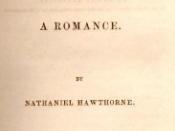Guilt, according to the American Heritage Dictionary, is the state of being responsible for committing wrongdoings and expressing remorse for those wrongdoings. A character is created with such guilt in The Scarlet Letter, a psychological novel written by a member of the Anti-transcendentalist Movement, Nathaniel Hawthorne. Arthur Dimmesdale's guilt leads to the eventual downfall and demise of his conscience and drives him to work hard toward redemption.
Dimmesdale's guilt leads to the eventual decomposition of his mind and conscience. He begins to act abnormally. Being a young minister, many women in the town fancy him. He refuses all of their marriage proposals, because of the thought of his sin with Hester. At one point, Dimmesdale becomes jealous of Hester. He believes that Hester is better off because her sin is known by the public, and she does not have to worry about being caught anymore. When Roger Chillingworth asks Dimmesdale if he thinks Hester is less miserable because of her public punishment by the scarlet letter "A", Dimmesdale responds "It must needs be better, for the sufferer to be free to show his pain, as this poor woman Hester is, than to cover it all up in his heart."
Arthur Dimmesdale's mind begins it demise when Roger Chillingworth believes that he is Hester's partner in adultery, after discovering Dimmesdale's torn chest. Chillingworth is constantly playing mind games with Dimmesdale and he constantly tries to leech information from him by tapping into his every thought and never letting up.
Arthur Dimmesdale's guilt leads to the downfall of his physical health. His remorse for his wrongdoings causes his to inflict pain and suffering upon himself by slashing and whipping his chest in his closet when he is in solitude. He inflicts physical pain upon himself because he feels that...


